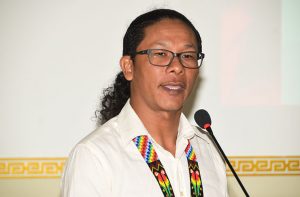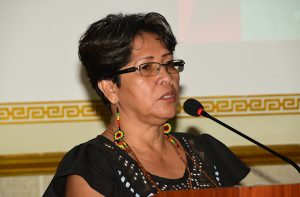– illegal mining/logging cited as threats to the future of indigenous communities there

THE cancellation of logging and mining concessions on titled and untitled lands obtained without free and prior informed consent, flaws in the village demarcations as well as discussions with villagers living close to the Kaieteur National Park are several recommendations made in a report on land tenure issues within Region Eight (Potaro/Siparuni).
The recommendations were made in an assessment undertaken by the Amerindian People’s Association (APA) which was undertaken over a two-year period, between 2015-2017 in the region. The body received support from the Forest People’s Programme (FPP) and the Rainforest Foundation US.
Speaking on the findings of the study, Michael McGarrel of the APA noted at the presentation ceremony of the assessment at the Regency Suites on Hadfield Street on Thursday, that it covered 22 settlements, 15 of which are titled. McGarrel said that the communities are located in the North Pakaraima Mountains, although most consider their customary lands to extend towards the South Pakaraimas down into the low-lying areas.
According to the findings of the study, 15 titled villages are experiencing problems with mining activities or the movement of unauthorised miners within their legally recognized title. It was noted that the villages of Micobie, Campbelltown and Karisparu are overlapped by mining concessions while the villagers at Monkey Mountain reported the presence of illegal miners who do not have concessions, while the village of Kanapang has reported the presence of miners travelling from Brazil into Guyana on the road that passes right through the Village.
“Micobie and Campbelltown, in particular, have had many mining concessions imposed on their title areas in the past, without their knowledge and consent,” the report stated. It was pointed out that since many of these were issued before the villages were officially granted titles, the government considers them as legal, since the title documents of Campbelltown and Micobie include a clause excluding ‘all privately owned lands legally held.’
It was stated too that of the 18 communities visited, 15 reported “some sort of land and resource conflict “ with third parties and the report stated that most of the issues relate to mining or forestry while some relate to the presence of shops on cattle ranches.
According to the findings of the report, two villages, namely Chenapau and Micobie , are experiencing increasing conflicts with protected areas that overlap their customary lands; Chenapou with the Kaieteur National Park and Micobie with Iwokrama National Protected Area. It was noted too that the plans for construction of the Amaila Falls hydropower project has been an issue of “ great concern” for the people of Chenapou, Kamana and other communities over the past few years.

For years, residents living at villages close to mining areas within the country’s hinterland have been at the mercy of miners, mainly as a result of pollution of the main waterways. The report stated that many of the communities that depend on customary areas around Siparuni, Potaro, Tipuru and Moruwa reported that commercial mining and logging are increasingly affecting game, fish and waterways that have always been healthy and abundant. It was reported that residents of the village of Monkey Mountain reported that there is heavy pollution caused by mining in the Echilebar area, Chenapou in Echerak and also at Campbelltown, Maikwak and Karisparu in the areas close to the villages.” Most of the villagers visited were worried that, with the way things are developing, their food and water security will be at risk in the future,” the report stated.
The extensive report also provides insight into the dwindling of food sources overtime in communities within Region Eight. According to the report, as the populations of most Amerindian communities are growing, there is increasing pressure on resources within the title. “This is made worse by the fact that the titles of all the villages only cover a small part of their customary lands and exclude areas that are suitable for farming. Pollution caused by mining also compounds this effect in several cases,” the report stated. In addition, it was noted that at the village of Kopinang, residents mentioned that changes in climate are affecting their crops.
It was noted that at some villages, recommendations were made to the effect that villagers should make greater efforts to pursue sustainable use of the resources.”Many communities have had such customary rules for generations, but some residents think the villages need to remind themselves of these practices,” the report stated. Executive Director of the APA , Jean La Rose, in providing a background of the project, noted that it comes on the heels of a similar assessment which was undertaken previously between 2012–2016 in Regions One (Barima/Waini) and Region Two (Pomeroon/Supenaam). The APA with assistance from its partners, is currently undertaking a similar study at villages in the Cuyuni/Mazaruni.



.jpg)









